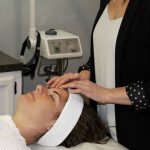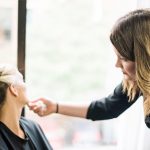
We care about the health of your skin; therefore, Carter Kayte will not perform a waxing treatment on your skin if:
If you are currently using any of the following prescription medications, you cannot receive a waxing service. Discontinue use of these medications for a minimum of three (3) months prior to waxing. The exception is Accutane: You must be off this medication for a minimum of one (1) year prior to waxing.
- Accutane (Acne Medication)
- Adapalene (Acne Mediciation)
- Alustra (Retin A)
- Avage (See Tazorac – Acne Medication)
- Avita (See Retin A)
- Azelex (Peeling agent)
- Clindamycin
- Differin (Acne Medication)
- Doxycycline
- Erythromycin
- Isotretinoin (See Accutane)
- Madifloxicine
- Metronidazole
- Renova (See Retin A)
- Retin A (Acne and Anti-aging Medication)
- Tazorac (Acne Medication)
- Tazarotene (See Tazorac)
- Tetracycline
- Tretinoin (See Retin A)
USE EXTREME CAUTION
The following products can make your skin more sensitive. Thin, sensitive skin is more vulnerable to lifting and sensitivity during waxing.
- Other acne medications not listed above
- Alpha Hydroxy Acids (Glycolic, Lactic)
- Oral Antibiotics
- Topical Antibiotics
- Retinol
- Salicylic Acids
- Any acid based products
- Exfoliants
Waxing and tweezing can cause the skin to be irritated and increase skin sensitivities. It is important to notify your esthetician of any sensitivities or irritations that you have encountered in the past. If your skin is prone to irritations, waxing and tweezing can increase the probability of a skin reaction.
THESE PRECAUTIONS AND CONSIDERATIONS SHOULD ALWAYS BE FOLLOWED:
You must wait a minimum of seven (7) days before waxing after a light chemical peel or microdermabrasion.
No waxing if you have had a laser skin resurfacing within the past year.
No waxing if you have had a physician administered peel within the past two (2) years.
Women may experience extra sensitivity to waxing up to a week prior to the beginning of their period.
No waxing on sunburned skin.
No waxing on irritated areas.
THE FACTORS LISTED BELOW ARE KNOWN TO MAKE WAXING MORE PRONE TO “SKIN LIFTING”:
Taking blood-thinning medications.
Taking drugs for autoimmune disease.
Medications for Lupus.
Taking prednisone or steroids.
Psoriasis, eczema, or other chronic skin diseases.
Recent cosmetic or reconstructive surgery.
Recent laser skin treatment.
Severe varicose leg veins.
Rosacea or very sensitive skin.
History of cold sores or fever blisters (waxing can cause a flare-up).
Clients with genital herpes (waxing can cause a flare-up). Your risk of infection is greatly increased.
Using hydroquinone.
Recent surgical peel, microdermabrasion or chemical peel using glycolic acid, alpha hydroxyl acid, or salicylic acid, or other acid-based products.
Moles cannot be waxed.
WHEN TO BE CAUTIOUS:
You’re pregnant, taking birth control, hormone replacement, or antibiotics. Your skin may be more sensitive to waxing. It is best to have a patch test 24 hours before getting waxed.
Smokers or those with Rosacea. Waxing can irritate dilated capillaries (weakened or broken blood vessels), which are common with smokers or people with Rosacea. If the capillaries are very red, stay away from waxing that area.
You take blood thinners, have diabetes, phlebitis or want post-cancer hair growth in the side-burn area removed. These all relate to medical conditions, so first get a doctors approval before waxing.
The use of powerful exfoliators on your skin. Salicylic, alpha-hydroxy acid.
You use any product with white willow bark. White willow bark extract and enzymes all strip cells from the skin. Your skin could become red, bleed, or even lift and turn scabby.
You recently consumed a lot of caffeine. This stimulant in your system can cause the skin to be extra sensitive to waxing, meaning you could get more red or inflamed than usual.
Drinking alcohol the day of or the night before waxing. Alcohol causes the blood to rise to the surface of the skin and can cause the skin to bruise easily.
NEVER WAX WHEN:
You currently take Accutane or have stopped taking it for less than a year.
You’re taking any prescription acne medication.
You have Lupus or Aids.
You’re in cancer therapy getting chemotherapy or radiation.
You have been in direct sunlight for a long period of time.
You have used a tanning bed within the last 24 hours.
You are sunburned.
Anywhere that has been waxed within the last 24 hours.
Areas you’re using any alpha hydroxy acids over 8%.
Over or around body piercings.
Anyone showing signs of irritation, inflamed, cut, redness, rashing, open and/or abraded skin, psoriasis, eczema, sunburn (from either tanning bed or natural sun exposure), active lesion(s) or Herpes Simplex I or II or a communicable disease can NOT receive a waxing service.
Note: If you take blood thinners, have diabetes, phlebitis or want post-cancer hair growth in the side-burn area removed: These all relate to medical conditions; therefore, a doctor’s approval is needed before waxing.
- For your first wax allow your hair to grow four (4) weeks before your first appointment. Stay on this schedule until your esthetician advises you otherwise.
- Never shave or tweeze between your waxing appointments. This throws off your hair growth pattern and you will never have the smooth skin you want.
- Never use lotions or body oils on the day of your waxing. These products will interfere with your waxing service.
- Exfoliate! Always exfoliate the night before your waxing appointment. Do not exfoliate to point where your skin is sore. It’s recommended that you use an exfoliating mitt (not a loofah) in the shower on a daily basis. Dead skin build up will not allow the hair to pop through.
- If you have or have ever had a problem with bumping (looks like a break out but its actually your follicles reacting to your waxing), bring a tube of Polysporin to your waxing appointment and apply immediately after waxing. Continue using as long as the bumps remain. If this happens it can last up to 2 weeks. After a few waxings, this will stop happening.
- If you are nervous about your waxing hurting, take a pain reliever/anti-inflammatory (Ibuprofen, Advil, Tylenol, etc.) 30 minutes prior to your waxing treatment to minimize discomfort. You may also apply No-Scream Cream about 45 minutes prior to your waxing appointment. This will numb your skin and take the discomfort down an average of 80%. No-Scream Cream is available for purchase at Carter Kayte.
- RELAX! Your esthetician is a professional and has been well trained.
-
- Remember to breath. Holding your breath causes you to tense up. Exhaling during the pull relaxes you.
- Depending on what you are getting waxed, you will be gently guided into positions that assure the best wax. Your esthetician may even ask you to help hold the skin tight. The tighter the skin the less it hurts.
- Inform your esthetician if the wax is to hot immediately.
- Minor blood spotting is normal, especially if your hair has been shaved over a period of time or if your hair is coarse and thick.
- Your esthetician will apply a post waxing cleanse and a post waxing calming liquid to you skin after waxing.
Home care is a must and it’s easy to follow.
The area of the skin that will be waxed may or may not be sensitive for 24-48 hours after waxing. To ensure maximum comfort and benefit after the treatment, it is important to follow the steps below at home:
-
-
- Schedule your appointment before you leave the studio. Keeping on a schedule will help you to maintain smooth skin and will greatly decrease the hair that grows back.
- Avoid applying heat to the waxed area for 12 to 24 hours. This includes, hot baths, sauna, and steam.
- Avoid sun exposure and tanning beds for 24 hours. This includes strong ultraviolet (UV) light exposure or tanning bed treatments.
- Avoid applying highly fragranced products to the waxed area. This includes, perfume, scented body lotions, antiperspirants, cosmetics, or feminine hygiene sprays. Only use professional products, recommended to you by the skin care therapist who performed the waxing service.
- For facial waxing, avoid cosmetics (makeup, lotions) and perfumes.
- For underarm waxing, avoid deodorant.
- After 72 hours, continue exfoliating to rid yourself of the dead skin build up that will trap the hairs and cause in-growns, but avoid using harsh abrasive exfoliants in the waxed area.
- If you’re prone to in-grown hair or at the first hint of one, do not wait until they become an issue to address them. Ask your esthetician products to apply if this occurs.
- If you get an infected ingrown use a Q-tip and apply hydrogen peroxide to the area. This will kill the infection.
- Do not pick! Picking causes scars.
- Avoid applying high SPF sunblock to the waxed area for 12-24 hours after the waxing service. Sunscreen chemicals can be irritating to the newly waxed skin. This includes self-tanning products and tan accelerators.
- Avoid low PH products such as glycolic/salicylic acids, Retin-A, topical acne products such as benzoyl peroxide, and the like for up to 72 hours.
- Avoid exercise. Sweating can clog your pores and friction can cause irritation.
- For bikini waxing, avoid “physical” exercise. Friction can cause irritation; sweating and oils can clog your pores.
-
Any pinking of the skin should disappear within 6 to 12 hours after the waxing treatment. Slight pinking is normal, and indicates that the hair was removed from the root, rather than superficially broken off, as in shaving. This is the reason that professional waxing lasts so much longer.
-
-
- What are the benefits to waxing over shaving?
While shaving may seem the less expensive option, waxing is the most effective option. Waxing removes the hair at the root, whereas shaving cuts the hair at an angle. Waxing slows down the regrowth process, allows the hair to grow back finer and softer, and keeps the skin smoother; whereas, shaving causes irritation, and the hair grows back coarse, stubbly, and faster. - What type of wax do you use?
I use a high quality hard wax, otherwise known as a non-strip wax, imported from France. It is a wax that doesn’t require a strip for removal. It is perfect for all skin types, even sensitive skin types. The great thing about this hard wax is that it only adheres to the hair and not to the skin. I only use a gentle, hypoallergenic soft (strip) wax on larger areas such as legs or back. - Does waxing hurt?
Yes, it can; however, it doesn’t hurt as bad as you may think. The first time is always the worst; but, by waxing regularly, the pain becomes very minimal and waxing gets easier. - How long or short should my hair be before waxing?
For best results, your hair should be as long as possible, preferably ¼ to ½ inch (length of a grain of rice). For first timers, I recommend at least ½ an inch. Please allow 4 weeks of hair growth before your visit. - How often should I receive a waxing treatment and how long does waxing last?
Hair grows in three stages; therefore, it can take up to 3-4 waxing treatments before all of the hair is on the same growth cycle. To keep hair coming back at a reduced rate, I recommend waxing every 4 weeks. However, some clients can experience a slower or faster rate; thus the time in between treatment can be adjusted according to the individual. To keep hair growing back at a reduced rate, it is best not exceed more than six weeks until your next visit. By waxing regularly, (normally after the first two waxes), you will have as close to a pain free wax as possible. Overtime, the hair will grow softer and finer and the hair will come out more easily. - Do I need to trim?
No. By trimming, you may accidentally trim the hair too short. - Do I need to exfoliate my skin?
I recommend exfoliating your skin 1-2 times per week. Exfoliation will remove dead skin cells, prevent bumps and ingrown hairs, and make your waxing treatment more effective. - Is there anything I should NOT do before a waxing treatment?
You should limit your caffeine intake and not drink alcohol the day of your waxing treatment. Caffeine and alcohol can stimulate the nervous system and can dehydrate the skin, causing the skin to become sensitive and the treatment to be more painful. - Is it safe to wax while I am pregnant?
Yes, it is safe to wax while pregnant; however, you should consult with your physician before waxing. - Is it safe to wax while I am on my period?
Yes. However, waxing on your menstrual cycle can be a little more painful because you are more sensitive. If you are seeking bikini wax services, I ask that you wear a tampon during service. - Is it okay to shave in between waxes?
No, I do not advise shaving in between waxing as shaving can irritate the follicles that causes ingrown hairs and make all that is gained from waxing (softer, finer, thinner hairs, less painful) ineffective.
- What are the benefits to waxing over shaving?
-
After your wax treatment:
For 24 hours after your wax treatment you should:
-
-
- Avoid sun exposure.
- Avoid exercise. Sweating can clog your pores and friction can cause irritation.
- For facial waxing, avoid cosmetics (makeup, lotions) and perfumes.
- For underarm waxing, avoid deodorant.
- For bikini waxing, avoid “physical” exercise. Friction can cause irritation; sweating and oils can clog your pores.
- After a wax, especially in the bikini area, you can always place a cold compress on the area waxed when you get home (i.e. ice pack, ice wrapped in paper towel). My personal and favorite technique is placing a clean, damp washcloth in a Ziploc bag and then place it in the freezer for just a few minutes. (You don’t want it to get too cold). Remove the washcloth from the Ziploc bag and apply it to the area waxed. This cold compress will help the pores close up a little quicker, make you feel better, and aid in reducing any redness.
-




